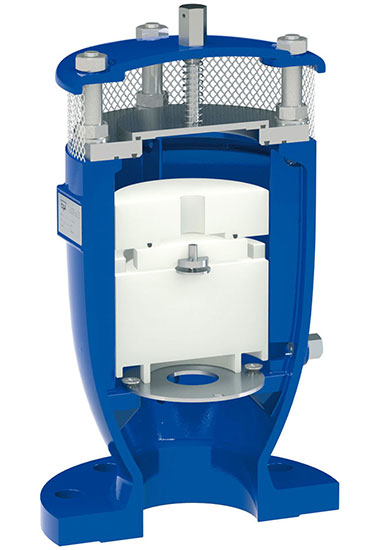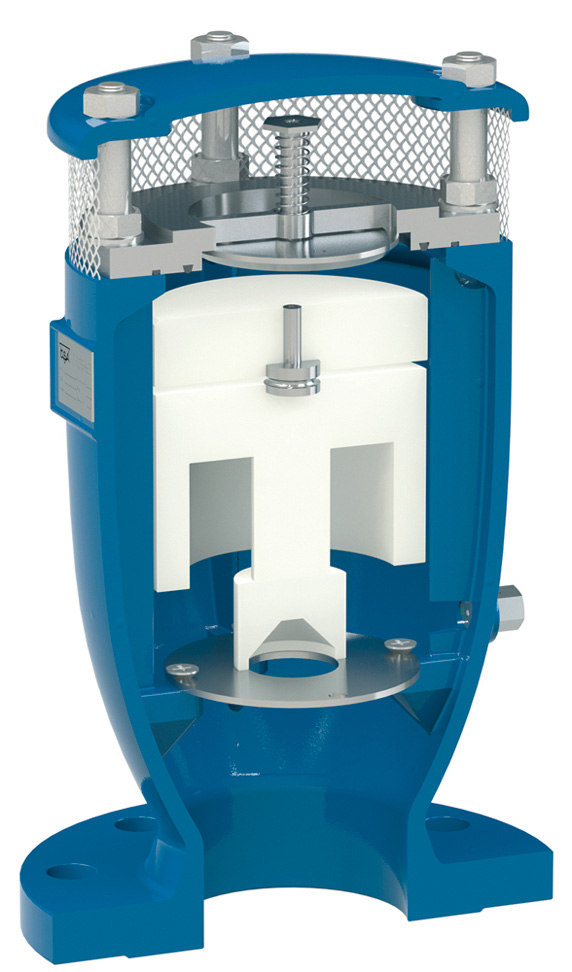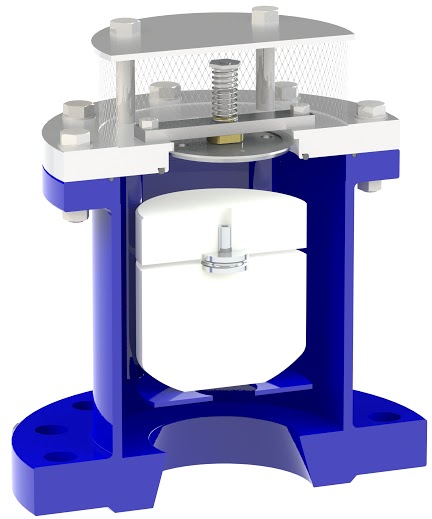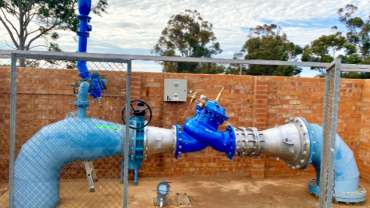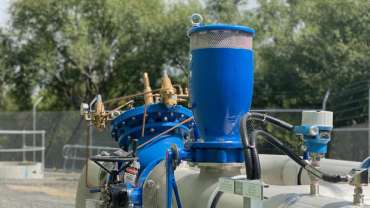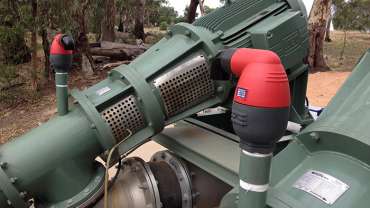Pipeline water hammer prevention using varying air release valve designs.
Play PodcastIn episode four, we continue our conversation with Colin Kirkland about water hammer in air release valves and how different pressure relief valves can be used effectively in any water network. From how the Bermad team approach minimising water hammer in complex installations, to providing potential solutions to real-world water pipeline problems with the latest technology, we cover all the basics—and more—in this episode of Controlling Water.
Transcript
| Sarah: | Hello and welcome to Controlling Water, a space for us to talk about water meters and interesting insights about the water industry. Each episode we’re joined in conversation by industry professionals that specialize in all things, valves, meters, and best practice knowledge in the water industry. We are here with Colin Kirkland, from Bermad water technologies, who is one of the engineers at BWT.
He has over 30 years industry experience working in pipelines that can be subject to water hammer. Colin, I’m really excited to talk to you about water hammer today. It’s a term that we hear a lot. It’s a very common issue. It can have significant consequences across a pipeline in a whole range of scenarios, so it’s really exciting that we get to chat in depth about it today. Before we get into some of the scenarios, and I know I’ve even got a tail of water hammer to tell you as well, what actually is water hammer? How would you describe it? |
| Colin: | Well, water hammer is a phenomenon that occurs in any water supply pipeline where you see a rapid increase in water, way and beyond what it normally would be acting, generally caused by a rapid change in flow. So if we see a rapid change in flow, where someone closes a valve very quickly, we tend to see a very sharp, rise in pressure, which then reflects back into the system.
Now this water hammer can travel at amazing speeds. If a pipeline is filled full of water and we’re traveling through, for example, a steel pipeline, it’ll travel up to a kilometer per second, a thousand meters per second. |
| Sarah: | Wow. |
| Colin: | But if it was a more flexible, lower pressure pipe, like polly, it may travel at three to 400 meters per second, but that’s still a very fast travelling pressure wave like traveling to a network caused by someone closing a valve. So, what is water hammer? A rapid change or a rapid increase in pressure beyond the snowball operating conditions generated by a rapid change in flow. |
| Sarah: | So interesting. So interesting. And it also makes this, with that change in pressure, it makes this incredible sound as well. |
| Colin: | It can, yes. It’s a little scary too, as well. |
| Sarah: | Yeah, it can be, it can be! I remember I used to live in an apartment building and we had water hammer appear. It was a very old building, beautiful building old pipes as well. And the water hammer appeared and it was so disruptive, it would happen at all times of day and night, completely unpredictable, and you’d think everything was just quiet and then you’d start to hear the knock and think no, not again. |
| Colin: | Yes. That situation that happens often. I can still remember my son who used to work night shift and he’d come home and have a shower at night and he turned the shower off and you’d hear a bang, bang, bang every night, you know? So yes, it happens as much as domestic and like in your situation, probably Sarah was someone opening and closing valves very quick. Because if you think about many years ago, we never used to have flick taps. So when we go to the sink, we have a tap that you can open and close instantly. In the old days we had taps we turned that took longer to close. We didn’t have as bad water hammer, but today we are generating lots of things that generate rapid changes in flow. That’s exactly what that is. So probably in your case, that could have been a case of someone turning some valves on and off. It could have been, we had some air in the hot water system returned that was compressing. It could be a multitude of things, but it’s common. It’s everywhere. It’s never going to go away, but we can deal with it and we can fix it. |
| Sarah: | I’m glad to hear that. So how does an air release valve in a pipeline reduce the effects of water hammer? |
| Colin: | Yeah. Good question. So even if I go back to the question you had with your apartment building, nearly every hydraulic engineer always tries to have a system. If there’s water supply in it to have only water, we don’t want air in it because if there’s air in a water pieline, it’s compressible. So if it’s compressible and we open a valve and allow water to flow, and then we shut it off instantly, it can create a bouncing effect where the pipes shake and everything happens.
Same thing happens in a very large commercial or in a mine or an irrigation that work exactly the same. How does a new release valve become part of it? So an air release valve is designed to automatically release any entrapped air if it’s present from the product from the pipeline. So it’s only water in there, so that can have a major impact. That’s that’s only one aspect of. The other aspect is, is that you can use air release fails for water hammer prevention. For example, if I were to fill the pipe at too fast a rate, I could create water hammer. If I put an anti-slammer valve in, I can control the rate of filling. So it comes out at a controlled rate and avoid water hammer. So, air release valves can be used in a multitude of different applications in any water network to ensure that we minimize water hammer for sure. |
| Sarah: | I’m going to ask you about anti slam in a moment, before I do, though, you mentioned this kind of vacuum with having air in a pipeline. Are there problems with breaking the vacuum? |
| Colin: | Yes. So ideally, as I was saying before, we don’t want air in the pipeline. But under some conditions, if I was to give you the most basic application, imagine we have a pump at a low point pumping up over a hill and as the hill goes down the opposite side, it flows into a tank. If we turn the pump off, the water traveling up towards the top of the hill stops, but the water at the top of the hill runs away down into the tank. At that time, we generate column separation. It’s a phenomenon where the pressure in the pipe drops below atmospheric pressure and airgets drawn into the pipe.
Now, when that air gets drawn, and the column then comes back together, if it releases too first, it generates water hammer. That’s the column separation problem. So we can put in an air release valve that can let the air in very fast, but let it out very slowly at a controlled rate to avoid the water hammer. And that’s, you mentioned before, what an anti-slam valve does. |
| Sarah: | Hmm. Interesting. Very interesting. So it sounds like then, the air release valves actually can generate water hammer in some ways. |
| Colin: | I’m really saddened to say that…so yes they can, yes.
So there’s a lot of modeling software out there, which engineers use to design pipelines and to look at water hammer aspects and they can actually model situations where that column separation occurs. And having a valve that’s really specifically designed for water column separation, like a Fox RFP, which we call it the rapid filling prevention or the anti-slam type air valve, again, I was saying, let the air in very fast, but at a controlled rate, let it release. And we know that’s effective. And the thing is today, there’s so much more information on how we can utilise these and if you have the right criteria, they enter into the modeling software and you can see its results are very, very well. So it’s safe and it’s proven today. 15-20 years ago, it was virtually unheard of. But today, you know, as everything advances in technology advances, it’s a really good way of utilizing a product to minimize water hammer and an air release valve in a whole scheme of things is a very small component. Usually a very, very small percentage of the cost of a whole network, but can be enormously effective. And to some people they think, well, it’s not expensive enough, but if you put it in the software and you see the results, it’s proven. |
| Sarah: | Interesting. Interesting. And this software really sounds like you can mitigate some of the risk and mitigate some of the complications that can occur with water hammer and really understand what your situation will be like by seeing it simulated. |
| Colin: | You’re seeing it real time, Sarah.
So, what you’re seeing is, let’s turn the pump off in five seconds, then turn it off in 10 seconds, let’s turn off in 20 seconds and see how the pressure wave actually operates. Let’s see how the components work in that situation. And yes, it takes or removes the risk, which is the key thing, because it simulates, hopefully, what’s going to happen, as long as you put the right information in. And that’s what we know very well at Bermad is how to assist the users of those products to make sure they’re being modeled correctly, to get the right results. |
| Sarah: | So valuable. |
| Colin: | Yes. |
| Sarah: | Let’s take a short break before we return to chat about minimising water hammer in complex installations with varying topographies.
You’re listening to controlling water, the Bermand podcast. Your primary source of insight for everything about water tech, valves, and meters. For more information on any of the products or topics discussed in this episode, plus a wide range of resources and articles designed to support you as water professionals, visit www.bermad.com.au. Now, back to the show. I’m conscious that we’ve spoken about some of the modeling software in another episode about water hammer. And we’ll add those details to the show notes of this episode, which is exciting. |
| Colin: | Great! |
| Sarah: | Wonderful.
So, I want to give you a scenario, Colin, so say your pipe design was really complicated, or it was in steep topography. What are the possible solutions that you could think of in order to minimize water hammer in this situation? |
| Colin: | Exactly. So there’s a multitude of different solutions, possibly, Sarah. So, in steep topography, you’ve usually got high, what we call static pressures. So when the pumps are not running, we’ve still got very high pressure in the pipeline, but when the pumps start we increase that pressure to enable the water to flow. So some of the solutions potentially, depending on what the results look like could be what we call a surge vessel or a one-way surge tank. Now, these are very large vessels of a specific size, which have a bladder inside them or air pressure, which help absorb the return wave and also ensure that we don’t get air coming into the network. They fill the void if there’s column separation, very good, proven technology, expensive, very large, really good solutions, but in some practical natures, it’s not practical.
For example, if we were in a major city and we had a large transfer station and we had tp put two 20,000 liter tanks next to a roadside. It’s wouldn’t be practical. So what are some of the other solutions? So there might be pressure relief valves. So, in other words, very, very fast acting, relief valves that can instantly take that pressure surge out. Or we might have air release valves that can allow the air in and control its discharge. Or we might even have a product that fits onto a pump to say: we’re going to stop that pump shutting down too quick; and it’s called pump control. So we’re basically going to, as the pump starts, we’re going to let the valve open very slowly and gradually and let the water fill gradually into the network. And when it turns off, well, before it turns off, we’re going to close this valve really nice and slowly and gradually, and then turn off once the flow is almost zero. So there’s many solutions for different applications, for different water qualities, different market segments that create the right price, solution and practical solution for the problem that can occur. |
| Sarah: | Fascinating, and so, let’s flip the scenario a bit. |
| Colin: | Sure. |
| Sarah: | Say you have a flat topography. What solutions would be appropriate? |
| Colin: | Yes. Sothere’s two very different situations. So let’s take a practical example of a farm in a very flat country area where with a very long network of pipes running out to sprinklers, for example. When you don’t have much static pressure or pressure that’s there when the pumps are turned off, you have a very high probability of column separation. That’s where, basically, the pressure of the pipe drops below zero air is drawn in and huge amounts. And then of course, when that air is in the pipeline, that’s collapsible, it can create water hammer. So we need products that can really mitigate that and release the air at a controlled rate.
So, even though things like search vessels would be ideal in that situation, they may be so large and so expensive for an irrigation grower to buy. It’s not practical. |
| Sarah: | Right. |
| Colin: | But if it was a water authority, they may decide, well, no, we’ve got the land, we’ve got the room. We may decide to do that. So it’s, what’s practical for what installation. It’s nothing against one or the other, it’s what’s right for the right job. |
| Sarah: | Definitely. Definitely. And are there low cost options available? |
| Colin: | Yes. |
| Sarah: | Does that exist? |
| Colin: | Absolutely. Well, air release valves are a really classic case of that because an release valve in a five kilometer pipe work might only be a $5,000 investment in something like that in a $10 million infrastructure. But the effectiveness of that product to actually work and control air discharge can be amazing and it’s proven. It can be modeled. It can be seen. And today the technology that’s grown to really show these products working well and effectively is proven. So we are very proud to be associated with that type of product, but it’s not just about having a product, but knowing you put it in the right application, the right location, and it’s able to be modeled correctly and seem to operate as it’s designed fit for purpose. |
| Sarah: | Definitely. It sounds like really weighing up and understanding all the factors that are involved are so critical to finding the right solution. So I’d like to talk about anti-slam valves.
What are the different air valve designs within an anti-slam valves that prevent water hammer? |
| Colin: | Absolutely. In the Australia, Sarah, there’s a whole sub section that describes what the different functions are. And there’s probably about four or five key different types of designs that many manufacturers incorporate, but typically they boil down to two main functions. One of them basically says, and it’s commonly known in the industry as RFP, rapid filling prevention. What that generally means is: I will allow controlled rates of air to discharge at a safe level, but if it goes to an uncontrolled level, in other words, the velocity leaving the valve is too great and I’m going to generate water hammer, I’m going to slow you down. |
| Sarah: | Right. |
| Colin: | So it says fit for purpose. Good. I let the valve fill and that’s really great. And allow large amounts of air back into the pipe, but it’s safe. The other situation we’ve got is we have what we call like an anti-slam air valve, which is designed, where we’ve got a water hammer issue. This is where we’ve got column separation. This is where we have large amounts of air coming into the pipe very quick to prevent vacuum. Then we have a very small orifice that discharges the air at a very, very slow controlled rate. So it uses that air pocket inside the pipeline to compress and make the two bits of water come back together very gently. |
| Sarah: | Hence the term anti-slam. |
| Colin: | Anti-slam! Exactly that’s right, because as much as it kills me, air valves can generate water hammer. But anti-slam valves are designed to prevent that. |
| Sarah: | Fantastic. So interesting. So if a fixed discharge orifice design, like anti-slam is best, should we use this type of air valve along the entire pipeline? |
| Colin: | Look, it can be done, Sarah, generally good but it’s not practice because most pipelines are being fully charged for most of their life. And they’re really only emptied during maintenance or some sort of major event happens. But in saying that there are many pipelines, for example, sewer rising mains that start and stop 300 times a day and we’ll fill and partially drain a pipeline every day.
So if we put anti-slam valves at every location, because they’ve got a limited small orifice for air discharge. It could take too long for that pipe to fill. So it’s not generally practical to put it at all installations unless the pipe is remained fully charged all of its time. So we would generally look at the anti-slap with the fixed orifice in strategic locations where it’s critical. At a pump station, at a point where you’ve modeled column separation, or maybe before a main section valve that when they physically close a very large valve, we just want to make sure that the column separation comes together very slowly. So it’s very, it’s more a strategic valve designed for a water hammer problem. |
| Sarah: | And it sounds like, just bringing back to the experience that Bermad has and the modeling software we were talking about as well, being able to make those strategic decisions about where to place this particular type of valve becomes critical. |
| Colin: | And that’s what a modeling software can do accurately, where I can’t. I’ve got a good gut feel where that’s going to happen, but it will tell you specifically at that location. And sometimes you look at the report and think it doesn’t look right, but that’s the fact of the matter. And that’s why sometimes when they’re being installed, people will question and say, don’t know why that isn’t fitted here, but anyway, that’s what we’re going to do. But the software really identifies it. |
| Sarah: | Fantastic, interesting. Colin, thank you for joining me today. It’s been a great chat about water hammer. I’ve learned so much. |
| Colin: | It’s a pleasure. Thank you. |
| Sarah: | For more learnings about the water industry, including products, tips, installations, operation, and maintenance techniques, head over to Bermad.com today. You and subscribe to our industry newsletter. You’ll join more than 3000 industry professionals and learn from the experienced Bermad team of industry specialists.
Thanks for tuning into this episode of Controlling Water. For more episodes, resources, and how to head to www.bermad.com.au today. |
-
Colin has more than 40 years’ experience working in water supply and irrigation in Australia, including 24 years with BWT. He credits his training at Weir pumps in his native Scotland for providing him with a solid grounding in engineering.
Colin is a mechanical engineer and a fitter and turner, who prides himself on taking a hands-on approach when designing and implementing successful installations across all aspects of BWT’s products and markets.
Read more about Colin: Who’s who at BWT – Colin Kirkland
Want more details?
To get more information about the training topics we offer, get in contact with our experts.




